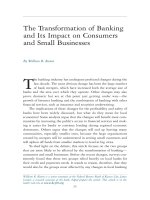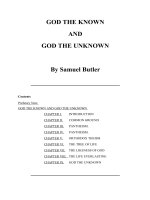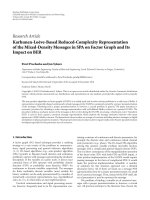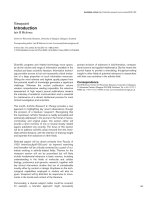Hagen welker (eds ) money as god; the monetisation of the market and its impact on religion, politics, law and ethics (2014)
Bạn đang xem bản rút gọn của tài liệu. Xem và tải ngay bản đầy đủ của tài liệu tại đây (2.48 MB, 470 trang )
Money as God?
The nature of money and its impact on society has long interested scholars
of economics, history, philosophy, law, and theology alike, and the recent
financial crisis has moved these issues to the forefront of current public
debate. In this study, authors from a range of backgrounds provide a unified
examination of the nature and the purpose of money. Chapters cover the
economic and social foundations of money; the historical origins of money
in ancient Greece, China, the ancient Middle East, and medieval Europe;
problems of justice connected to the use of money in legal systems and legal
settlements, with examples both from ancient history and today; and theological aspects of monetary and market exchange. This stimulating interdisciplinary book, with its non-technical and lively discussion, will appeal
to a global readership working in the interfaces of economics, law, and
religion.
ju¨ rgen von hagen is Professor of Economics and Director of the
Institute for International Economic Policy at the University of Bonn,
Germany. His research focuses on monetary and macro-economics. As a
Protestant preacher, he also has a keen interest in theology and its intersection with economics.
michael welker is Senior Professor of Systematic Theology at the
University of Heidelberg. He is a member of the Heidelberg Academy of
Science and Humanities and a corresponding member of the Finnish
Academy of Arts and Sciences. He has held guest professorships at numerous universities, including Princeton Theological Seminary, Harvard
Divinity School, and Cambridge Divinity School. He is the author or editor
of around 50 books.
Money as God?
The Monetization of the Market and its
Impact on Religion, Politics, Law, and Ethics
Edited by
j u¨ rgen von h agen
and
michael welker
University Printing House, Cambridge CB2 8BS, United Kingdom
Cambridge University Press is part of the University of Cambridge.
It furthers the University’s mission by disseminating knowledge in the pursuit of
education, learning and research at the highest international levels of excellence.
www.cambridge.org
Information on this title: www.cambridge.org/9781107043008
© Cambridge University Press 2014
This publication is in copyright. Subject to statutory exception
and to the provisions of relevant collective licensing agreements,
no reproduction of any part may take place without the written
permission of Cambridge University Press.
First published 2014
Printed and bound in the United Kingdom by Clays, St Ives plc
A catalogue record for this publication is available from the British Library
Library of Congress Cataloguing in Publication data
Money as God? : the monetization of the market and the impact on religion, politics,
law, and ethics / edited by Jürgen von Hagen and Michael Welker.
pages cm
Includes index.
ISBN 978-1-107-04300-8
1. Money – Philosophy. 2. Money – Social aspects. 3. Money – Moral and
ethical aspects. 4. Money – Religious aspects. I. Hagen, Jürgen von, editor of
compilation.
HG220.3.M65 2014
332.401–dc23
2013036997
ISBN 978-1-107-04300-8 Hardback
Cambridge University Press has no responsibility for the persistence or accuracy of
URLs for external or third-party internet websites referred to in this publication,
and does not guarantee that any content on such websites is, or will remain,
accurate or appropriate.
Contents
Figures
page viii
Tables
ix
Contributors
x
Acknowledgments
Introduction
ju¨ rgen von hagen and michael welker
I.
Money and markets: economic, legal, and theological
foundations
xii
1
17
1. Microfoundations of the uses of money
ju¨ rgen von hagen
19
2. Money and its role in a decentralized market economy
peter bernholz
42
3. Mensura et mensuratum: money as measure and measure
for money
wolfgang ernst
4. Standardization and monetization: legal perspectives
burkhard hess
5. Kohelet and the co-evolution of a monetary economy
and religion
michael welker
60
80
96
v
vi
Contents
II.
Monetary exchange: historical and social roots
6. Money and image: the presence of the state on the routes
of economy
tonio ho¨ lscher
7. The social world of Ecclesiastes
choon-leong seow
109
111
137
8. The development of monetary systems in Palestine during
the Achaemenid and Hellenistic Eras
ulrich hu¨ bner
159
9. Fate’s gift economy: the Chinese case of coping with the
asymmetry between man and fate
rudolf g. wagner
184
10. “Mothers and children”: discourses on paper money
during the Song period
hans-ulrich vogel
219
11. “Buying Heaven”: the prospects of commercialized
salvation in the fourteenth to sixteenth centuries
berndt hamm
233
III.
Monetary exchange: ethical limits and challenges
12. The monetization and demonetization of the human body:
the case of compensatory payments for bodily injuries and
homicide in ancient Near Eastern and ancient Israelite
law books
konrad schmid
257
259
13. What price do we place on life? Ethical observations on the
limits of law and money in a case of transitional justice
gu¨ nter thomas
282
14. Standardized monetization of the market and the argument
for preferential justice
piet naude´
309
Contents
vii
15. Religious faith and the market economy: a survey on faith
and trust of Catholic entrepreneurs in China
gao shining and yang fenggang
IV.
Money, wealth, and desire
339
363
16. “Do not sell your soul for money”: economy and eschatology
in biblical and intertestamental traditions
365
andreas schu¨ le
17. “Businessmen and merchants will not enter the places of
my Father”: early Christianity and market mentality
edmondo f. lupieri
379
18. Desire in consumer culture: theological perspectives from
Gregory of Nyssa and Augustine of Hippo
john f. hoffmeyer
414
Money as God?: conclusions
michael welker and ju¨ rgen von hagen
Index
440
442
Figures
2.1 Trilateral barter
2.2 Development of prices in four countries, 1790–1990
2.3 Development of the cost of living, 1950–1995
viii
page 43
47
48
Tables
2.1 Historical examples of large under- (< 100) and
overvaluations (> 100) of currencies
page 50
2.2 Historical episodes of hyperinflation
51
12.1 Exchange rates between 1 shekel of silver and
corresponding quantities of bronze, copper, tin, and gold
(in shekels)
264
12.2 Fines and punishments for injuries and homicide in
the CH
266
12.3 Fines and punishments for injuries and homicide in
the CU
267
12.4 Fines for injuries and unintentional homicide in the CE
268
12.5 Comparative Listing of fines and punishments for injuries
and unintentional homicide in the CU, in the CE, and in
the CH
269
15.1 Business structure of enterprises
343
15.2 Relations with administrative organs
343
15.3 Participation in religious activities
348
ix
Contributors
Name
peter bernholz
wolfgang ernst
yang fenggang
berndt hamm
burkhard hess
john f. hoffmeyer
tonio ho¨ lscher
ulrich hu¨ bner
edmondo f. lupieri
piet naude´
konrad schmid
andreas schu¨ le
choon-leong seow
x
Affiliation
Professor Emeritus of Economics,
University of Basel
Professor of Law,
University of Zurich
Professor of Sociology and Director of the
Center on Religion and Chinese Society,
Purdue University, West Lafayette
Professor Emeritus of Theology, University
of Erlangen
Professor of Law,
University of Heidelberg
Professor of Theology,
Lutheran Theological Seminary,
Philadelphia
Professor of Ancient History,
University of Heidelberg
Professor of Theology,
University of Kiel
Professor of Theology,
Loyola University Chicago
Professor of Religion,
Port Elizabeth, South Africa
Professor of Old Testament,
University of Zurich
Professor of Old Testament,
University of Leipzig
Professor of Old Testament,
Princeton Theological Seminary
Contributors
gao shining
gu¨ nter thomas
hans-ulrich vogel
ju¨ rgen von hagen
rudolf g. wagner
michael welker
xi
Professor of Religion, Beijing
Chinese Academy of Social Sciences
Professor of Theology and Ethics,
University of Bochum
Professor of Chinese Studies, University of
Tübingen
Professor of Economics,
University of Bonn
Professor of Chinese Studies, University of
Heidelberg
Professor of Theology,
University of Heidelberg
Acknowledgments
This book documents the results of a multi-year international and
interdisciplinary dialogue. The project was made possible by the
Evangelische Kirche im Rheinland, Düsseldorf, Germany. We are
most grateful to Präses Dr. Nikolaus Schneider, Vizepräses Petra BosseHuber, Vizepräses Christian Drägert, Professor Dr. Bernd Wander,
and the staff of the Film Funk Fernseh Zentrum (FFFZ) for their
kind support. We are also indebted to Dr. Ellen Peerenboom, Gudrun
Strehlow, and the team of the Internationales Wissenschaftsforum
(IWH), University of Heidelberg. We acknowledge our gratitude to
Dr. Heike Springhart, who was a perfect organizer of the project
over many years. Special thanks go to Henning Mützlitz, Heidelberg,
who created a print-ready copy, and to Cambridge University Press
for their cooperation.
xii
Introduction
JÜRGEN VON HAGEN AND MICHAEL WELKER
Over the centuries, time and again, theologians, philosophers, poets and
even sociologists have proposed that money should be regarded as a
“god-term” (Kenneth Burke). They have spoken of the omnipotence of
money (Georg Simmel) and pondered whether we should not organize
religious faith like money (Niklas Luhmann). They propagated a “pantheism of money” (Falk Wagner) and called it the “all-determining
reality.”1
This treatment of money as a god-like phenomenon stands in sharp
contrast to another tradition which, in the European context, goes back
at least to Luther’s polemical use of the phrase, “You cannot serve God
and mammon” (Matt. 6:20, Luke 16:13) and his explanation of the first
article in his Great Catechism which puts God and Mammon in strong
opposition to each other: “Many a one thinks that he has God and
everything in abundance when he has money and possessions; he trusts
in them and boasts of them with such firmness and assurance as to care
for no one. Lo, such a man also has a God, Mammon by name. It is
money and possessions on which he sets all his heart and which are also
the most common idols on earth. He who has money and possessions
feels secure, and is joyful and undismayed as though he were sitting in
the midst of paradise. On the other hand, he who has none doubts and is
despondent, as though he knew of no God. For very few are to be found
who are of good cheer, and who neither mourn nor complain if they
have not Mammon. This care and desire for money sticks and clings to
our nature, even to the grave.” Luther thus demonizes money as an idol
trapping humans by promising them a false security and luring them
into putting their trust in material goods rather than the living God.
This tension between a tradition of deification and a tradition of
demonization of money is the starting point of the research project on
which this book is a report. The chief goal of this project was to bring
1
See Tonio Hölschers’ contribution in this book, Chapter 6 below.
1
2
Jürgen von Hagen and Michael Welker
together scholars from different academic disciplines to compare and
discuss the views on money their respective disciplines offer. The project
did not aim at developing a unified perspective on money shared by all
disciplines. Instead, it took a multidisciplinary approach, one that
accepts the differences between different disciplines and traditions,
and uses these differences to promote a discourse that can affect the
research and thinking in each one of them. For this end, the project
involved economists, historians, lawyers, sinologists, and theologians,
who met several times over a period of three years to develop and
discuss their contributions.
I. Money and markets: economic, legal, and ethical
foundations
In “Microfoundations of the uses of money,” Jürgen von Hagen provides a thorough introduction to the economic fundamentals of monetary economies. The fundamental function of money is to be a general
medium of exchange. Money is characterized by three properties: it is
storable, it is accepted in exchange for goods which are desirable for
consumption without being the object of consumption itself, and it is
nameless. Since the use of money is costly in terms of real resources, it
emerges as a social institution only if it is supported by two key characteristics of a society’s trading system. The first is decentralization,
implying that trade takes time. The second is a lack of trust among those
trading with each other which destroys the possibility of trading on the
basis of credit. Where these conditions do not hold, money will not
emerge.
Von Hagen then goes on to draw out the implications of these microfoundations for the current research project. One argument concerns
the ambivalent role of government in monetary economies: government
can supply the trust individuals must have in an anonymous medium of
exchange, but government can also abuse this trust to reap the gains
from money creation. Another argument concerns the social and economic developments required for money to emerge and be sustained as
a social institution. Here, von Hagen formulates a set of questions to the
other researchers involved in the project.
In “Money and its role in a decentralized market economy,” Peter
Bernholz delves more deeply into some of the aspects developed in
the previous chapter. He explains the idea of monetary trade in
Introduction
3
more detail and focuses in particular on the role of government in
monetary affairs. Bernholz reviews the history of hyperinflations in
the past few centuries and argues that these hyperinflations were due
to attempts by the governments to over-exploit money creation as a
source of revenue. This was facilitated by the move from metal-based to
credit money and, later, pure fiat, or paper money. In the last part of his
chapter, Bernholz discusses the perceptions of the social role of money
as reflected in literature and philosophical writings. These perceptions
often ascribe to money a power of changing social relations and values.
This links up with the discussion in von Hagen’s chapter, i.e. that
this may be a misperception: changes in social relations and values
due to changes in economic and trading structures are ascribed to
money, because the use of money emerges as a result of these structural
changes.
Wolfgang Ernst, in “Mensura et mensuratum: money as measure and
measure for money,” discusses the use of money as a unit of account, or
measure of value. He begins with a review of the use of money as a unit
of account in the Middle Ages, a particularly interesting period during
which the “money” serving as a unit of account did not coincide with
the money used as a medium of exchange, a possibility discussed earlier
by von Hagen. As Ernst points out, this is a period when thinking about
the value of a good was dominated by religious and ethical concepts
such as the “true” or “fair” price. Money was regarded as a measure of
this objective value of things, a notion that led to the postulate of
monetary stability. For example, Ernst reports that Thomas Aquinas
argued that, since all measures must be stable, so must money as a
measure of value.
Ernst then goes on to discuss the special problems of bimetallism,
where the value of different coins is tied to different precious metals
rather than one (usually gold and silver), and imaginary money, where
the unit of account does not correspond to the actual coins circulating.
In bimetallic systems, swings in the market price of one metal against the
other can cause deviations of the exchange rate between different coins
from their relative face values. If these swings were persistent, the face
values of the coins were adjusted or official, regulated exchange rates
were applied. With imaginary money, the unit of account becomes
completely abstract, while the value of the coins used as a medium of
exchange itself becomes variable against the unit of account. Finally,
Ernst discusses modern fiat money, where the medium of exchange is no
4
Jürgen von Hagen and Michael Welker
longer tied to any commodity. He argues that fiat money can no longer
be regarded as a measure value of all other things; instead, the price of
all other things becomes the measure of the value of money. This
contradicts the medieval notion of an objective value inherent in all
things, but it is fully consistent with modern economic thinking which
holds that relative prices are the result of the interplay of consumer
preferences and scarcities of supply.
In “Standardization and monetization: legal perspectives,” Burkhard
Hess addresses the issues of standardization and the use of money from
a legal perspective. Hess points out that all contractual relations which
can be enforced by courts require some standardization – a definition of
what is equal and common in repetitive human actions and relations is
necessary for a judge to rule what is right or wrong and to award
compensation for damages where necessary. Standardization is not
limited to economic relations; it is found also in other parts of civil
law. Standardization facilitates the settlement of conflicts, but it also
comes at a price, as the standards set may be perceived as unfair by the
weaker parties in a conflict. In modern legal systems, judges are empowered to intervene in such cases and impose what is perceived in society as
fair conditions of exchange.
In the legal context, monetization refers to the use of money to make
payments and settle accounts in commercial relationships. Beyond that,
it also refers to the use of monetary payments to compensate for
injustice, tort, and losses of non-tangibles. Modern legal systems use
this instrument pervasively, to settle conflicts. Thus, as pointed out by
Bernholz, the complaints of writers and philosophers that things that
were once highly valued have lost general esteem in society and have
been degraded by the fact that they can be purchased for money, may
actually reflect development of standardization in legal systems more
than a supposedly evil property of money. Hess uses two specific
examples – monetary compensation of the loss of intangibles and
monetary transfers paid to the victims of mass tort – to illustrate the
conflict between justice and standardization. The second example is
discussed in more detail in Günter Thomas’s chapter.
Michael Welker’s “Kohelet and the co-evolution of a monetary economy and religion” begins with the observations that money has been
ascribed god-like features by theologians, philosophers, poets, and
social scientists. A well-known example is Martin Luther, who confronts us with the imperative to choose between “God and Mammon.”
Introduction
5
Welker finds that this is a distorted view not only of money and markets,
but also of God. He focuses on the biblical book of Kohelet to correct
these distortions. At a first glance, Kohelet’s teaching seems to be
characterized by the contradiction between his emphasis on the futility
of all material things on the one hand and his repeated admonition that
man should enjoy the things he possesses. On the one hand, wealth and
money provide neither security nor the fulfillment of human desires; on
the other hand, Kohelet advises his reader to sow and reap and enjoy the
fruits of his labor.
This apparent contradiction, Welker argues, is resolved by the distinction between property as wealth and property as God’s gift. As a gift
of God, wealth should be enjoyed. It should not, however, be brought
into the sphere of the market and the monetary system, because doing so
involves the risk of losing it. Property as a gift can mean much more
than just material possessions; it can include non-tangibles such as
talents, and cultural and social institutions. Wisdom is the art of distinguishing between properties as non-marketable gifts and properties
as marketable assets which can be purchased and sold in the market.
Welker argues that Kohelet is also characterized by viewing a person’s relationship with God from a perspective of profit, which is
anticipated, but by no means sure. God relates to individual human
beings only indirectly, by granting them, or depriving them of, possessions as gifts, and the opportunity to enjoy them. The human’s role in
this relationship is to actively enjoy what God has given him. Yet, from
the human perspective, this relationship with God is highly unpredictable; therefore, his life is marked by a large degree of uncertainty and
instability. As Welker points out, referring to Seow’s commentary on
the book, this view of life may be a reflection of the increased degree of
social and economic mobility in the Palestinian society under the
Persian empire.
II. Monetary exchange: historical and social roots
Tonio Hölscher, in “Money and image: the presence of the state on the
routes of economy,” investigates the historical social environments in
which coined money was first invented. The first known coins were
introduced in the Greek state of Lydia in the seventh century bc.
Hölscher argues that their introduction fell into a period in which the
Greek economy underwent a deep transformation. In the pre-monetary
6
Jürgen von Hagen and Michael Welker
economy, economic transactions were based mainly on barter trade and
gifts exchanged between leaders, which symbolized long-term relationships based on mutual trust. In the decades around 600 bc, a prosperous middle class emerged in the cities, whose economies were
characterized by a much larger degree of the division of productive
tasks among individuals and families, and where the city-states began
to assume greater roles than before in public life. Public building projects – both for civic and religious purposes – were at the center of the
states’ activities. Hölscher argues that these state-sponsored public
works promoted the development of monetary economies, as money
made it possible to store large amounts of wealth and to pay large public
workforces on a continuous and regular basis. Hölscher explains that in
the strongly decentralized political system of Greece, the value of money
was certified and assured by the same communities of citizens that
acknowledged this value in everyday trade. The spreading of monetary
exchange implied that exchange relations lost their personal character
of gift-giving and instead became impersonal market transactions, leading to a deep transformation of Greek economic life.
Hölscher also discusses the function of coins as images circulating
within and outside the territorial realm of the political authority issuing
them. Throughout the centuries, Greek and, later, Roman authorities
used coins to present themselves and to send messages to their citizens
and beyond.
Leong Seow notes in “The social world of Ecclesiastes” how much
the language of Kohelet presupposes a readership that is familiar with a
society embedded in an economy characterized by a high degree of
commercialization and monetary exchange. Seow places the book in
the era of Persian rule over Palestine and argues that archeological
evidence is (partly, at least) consistent with such an economic basis.
The economy in Yehud was still largely agrarian, but it was private and
profit-oriented agriculture. Seow’s argument is based on his observation
of Kohelet’s frequent use of terms which are also found in Persian legal
and economic documents, and of strong parallels between the theological concepts put forward by Kohelet and legal and political concepts
prevailing under the Persian rule. In particular, Seow points out,
Kohelet’s view of God who is completely sovereign (and perhaps somewhat arbitrary) in what he chooses to give to or withhold from individual persons resembles the Persian kings’ custom of giving and
withdrawing grants to and from individual citizens.
Introduction
7
The social world of Ecclesiastes was characterized by a large degree
of social mobility and uncertainty about social positions which can also
be found in the book of Kohelet. Individuals of low social rank could
find and grasp opportunities to climb the social ladder and gain substantial wealth and influence, but they could also lose both quickly.
Facing such opportunities, some individuals devoted their lives entirely
to the accumulation of wealth, sometimes only to end up in poverty.
With a larger set of economic opportunities, economic inequality
increased and so did the perception of economic injustice. Both
are well reflected in the writing of Kohelet. While some people were
able to benefit massively from the opportunities to become rich, the
average person in society felt helpless and oppressed by a powerful and
arbitrary king and a rich elite.
In “The development of monetary systems in Palestine during the
Achaemenid and Hellenistic Eras,” Ulrich Hübner describes the history
of money in Palestine, which evolves in parallel and reflects the political
history of the region and the influence of external forces. Hübner argues
that the introduction of coins must be interpreted as a gradual improvement of pre-monetary exchange rather than a major cultural innovation. For a long time, coins that were used in long-distance trade
circulated alongside coins of local and regional origin that were used
in local and regional trade only. At the same time, trade based on the
exchange of metal bars that needed to be weighed continued to exist for
long periods of time.
While the first coins used in Palestine were of Greek origin and date
from the sixth and fifth centuries bc, Sidonian and Tyrrian coins
became the leading currencies in the region during the middle of the
fifth century bc and into the Roman era. In the middle of the fourth
century bc, coins were minted in the province of Yehud (Judah), most
likely in its capital, Jerusalem. These coins bore images that contributed
to the shaping of a Yehud identity separate from the neighboring
regions. They were produced until the early Ptolemaic period; local
minting only started again at the end of the Seleucid Empire and the
beginning of the Hasmonean rule.
“Fate’s gift economy: the Chinese case of coping with the asymmetry
between man and fate” by Rudolf Wagner, discusses the role of spiritual
money offered in religious rituals in China and its interpretation.
Wagner develops a view of the gift economy that relates the world of
the living with the supernatural world in Chinese spiritual traditions.
8
Jürgen von Hagen and Michael Welker
In this economy, human life is regarded as an initial credit given to a
human being with the expectation of man paying back in the form of
morally acceptable deeds. It is based on the fundamental tenet that
supernatural powers do not act randomly and that man can exchange
good actions for good fate, although the specific terms and ways of this
exchange are not known to human beings. The relationship between
human beings and the supernatural powers involves a large degree of
standardization, which is embodied in a system of karma points that
can be earned by good and squandered by bad deeds. This standardization lends itself to the use of spiritual money as a currency representing
the value of good deeds. Wagner emphasizes that the valuation of this
currency is not tied to the value of money used in ordinary human
business transactions. On the contrary, paper money is postulated to
have higher value in the spiritual realm than metal coins. As in ordinary
credit relations, the Chinese tradition holds that the good deeds of one
person may be accredited to another and contribute to the efforts of the
latter to manage and pay back his life credit.
As Wagner points out, the traditional scholarly view of this relationship between the world of the living and the supernatural world
interprets it as a translation of ordinary, real-life institutions and relationships to the spiritual realm. The main point of this chapter is that the
inverse can also be true and serve as a fruitful hypothesis: what is
assumed to be true about the supernatural world and its relationship
with human beings serves as a model for ordinary economic transactions among humans. Wagner notes that, in Chinese tradition, the
enforcement of business contracts explicitly relies on the punishment of
devious behavior by spiritual powers. Furthermore, the development of
Chinese banking is intimately linked to the Buddhist monastic tradition
and its thinking about money and interest. Finally, the use of paper
money, which was first invented in China, in ordinary economic transactions, may derive from the use of spiritual paper money in religious
rituals. This would involve a translation of the emphasis on truth and
good moral behavior in the spiritual realm to the credibility of the
promise of a stable value of a currency with no backing other than
paper.
In “‘Mothers and children’: discourses on paper money during the
Song period,” Hans-Ulrich Vogel continues on the theme of paper
money raised in Wagner’s contribution. He reviews the debate among
Chinese scholars and officials surrounding the introduction and the use
Introduction
9
of paper money in the late tenth century and from the twelfth to the
seventeenth century in some Chinese provinces. Paper money was
introduced as an alternative to iron and copper coins, which were
inconvenient in trade due to their heavy weights. Its issuance was
soon taken over by the state. Paper money regimes were plagued by
the tension between the need to limit the amount of money circulating in
order to preserve a stable value of money and the fiscal demands of the
state. Vogel cites from a record of a discussion between a Shenzong
emperor and his officials which brings out this tension very explicitly
and shows that the fiscal demands of the state typically prevailed.
The review of the debates shows that paper money regimes were also
plagued with counterfeiting. Excessive issuance and counterfeiting of
paper money caused wealthier merchants to hoard coins, which made
trading more difficult for ordinary people, as paper notes were not
available in small denominations, and thus resulted in economic downturns and hardship. As a result, paper money was met with criticism and
suspicion by many Chinese scholars and officials of that period.
Berndt Hamm’s chapter, “‘Buying Heaven’: the prospects of commercialized salvation in the fourteenth to sixteenth centuries,” describes the
theological response to the commercial revolution and the emergence of a
monetary and capitalistic economy in Europe during the eleventh to the
thirteenth century and until the Reformation. On the one hand, the
Church adopted concepts from commercial life in its theology, teaching
that God offered man a contract by which man could buy heavenly
treasures for good deeds and donations of money (rather than land, as
during the times of the feudal economy), thus providing the new class of
rich merchants, bankers, and tradesmen with an assurance of salvation.
In contrast to the Chinese gift economy described by Wagner, this contractual relationship is characterized by a very calculable principle of do
ut des, which is perfected in the sale of indulgences. On the other hand,
the Church gave legitimacy to the new economic system and itself became
heavily involved in it as a financial actor. Thus, Hamm argues, the
relationship between the Church and the commercial world is a dialectic
one. The Church shapes it and is shaped by it.
The commercial logic of buying salvation became the main point of
attack by the Reformation, which held the principle of God’s free and
unmerited grace against it. Hamm argues that the Reformers’ critical
attitude against money must be seen against the background of common teaching that money could be used to buy salvation. Moreover, the
10
Jürgen von Hagen and Michael Welker
Reformers had a tendency to demonize money and monetary exchange
precisely because the Catholic Church was so deeply involved in monetary dealings. Nevertheless, Hamm shows, Lutheran and Calvinist
theology found ways to adjust to the developing capitalist economic
system.
Hamm concludes that Christian religion was never a driving force
behind the development of the capitalist economy in Europe, but it
became an important ally in many ways, providing the economic system
with legitimacy, credibility, and, thus, stability. As the capitalist economy increasingly detaches itself from this ally, Hamm suggests, it may
end up losing an important pillar of stability.
III. Monetary exchange: ethical limits and challenges
In “The monetization and demonetization of the human body: the
case of compensatory payments for bodily injuries and homicide in
ancient Near Eastern and ancient Israelite law books,” Konrad
Schmid picks up an argument introduced by Burkhard Hess, i.e. the
use of standardization in legal contexts, and describes how this was
already practiced in Near Eastern legal codes of the eighteenth and
twenty-second centuries bc. These codes spelled out compensatory
payments for bodily injuries that were graded by the severity of the
injury, the function of the body part injured and the social status of the
person injured. The values implied by these payments varied over time.
Apart from the compensatory function, the payments also seem to have
served a role of deterrence and punishment.
In comparison to these ancient law codes, Schmid argues that the
Israelite covenant code makes less use of compensatory payments. In
particular, it does not allow for payment compensating for the taking of
a human life, and it does not specify set values of payments for any
bodily injury. Schmid attributes this to the fact that the Palestinian
economy became monetized much later than the more developed
economies in the region.
Günter Thomas continues this theme in “What price do we place on
life? Ethical observations on the limits of law and money in a case of
transitional justice,” but he looks at it from a different angle, namely,
the use of monetary payments by the state to make good injustices
suffered by its citizens. The case he considers is the payment of reparations to citizens of the former German Democratic Republic who
Introduction
11
suffered from political persecution. Is such a monetary compensation
possible at all?
The difficulty in this case and similar ones comes from the fact that the
injustices were committed by a political regime different from the state
paying reparations, and that the compensation is made by an institution
rather than an individual as a moral agent. Justice is sought to be done
for the victims, but not for the perpetrators. Thomas provides a detailed
discussion of the complex ethical issues involved in the setting of compensatory payments for large numbers of victims. It forces the state to
establish a monetary price for an imaginary unit of injustice such as a
month in forced-labor camps, and thus enforces a standard of comparison on individual suffering which by definition is incomparable to any
other suffering.
As Thomas points out, public art, public narrative and religion offer
alternatives to monetary compensation in dealing with injustices suffered by large numbers of people. In the German case, these alternatives
were neglected, and deplorably the churches did not play an active role
reminding the German people of these alternatives.
Piet Naudé’s “Standardized monetization of the market and the
argument for preferential justice” begins with a brief review of the
history of the global economic system from the mid-nineteenth century
to date. Naudé argues that, despite the differences in the global trading
and financial regimes over time, this history is characterized by the everlarger differences between the center and the periphery of the global
economy. While the standardized market system is based on voluntary
exchange and reciprocity among equals as a conception of justice, these
growing differences call for a new concept of justice, one that gives
unambiguous preference to the poor. This call has been voiced by
theologians in the form of liberation theology, by philosophers, most
prominently by John Rawls, and recently by the economist and Nobel
Laureate Joseph Stiglitz.
Naudé reviews all three strands of thinking and shows how they
converge on the principle of preferential justice for the poor, despite
their very different starting points and methodological approaches.
Preferential justice for the poor is served when those who are better
off contribute to the economic well-being of the poorest.
Naudé proposes that this principle should also be applied at the local
as well as the global scale of human society and politics. The fact that
this has been argued from three very different bases gives it the









